Antibody data
- Antibody Data
- Antigen structure
- References [51]
- Comments [0]
- Validations
- Immunocytochemistry [6]
- Immunohistochemistry [3]
- Other assay [12]
Submit
Validation data
Reference
Comment
Report error
- Product number
- MA5-11344 - Provider product page

- Provider
- Invitrogen Antibodies
- Product name
- Cytokeratin 15 Monoclonal Antibody (LHK15)
- Antibody type
- Monoclonal
- Antigen
- Synthetic peptide
- Description
- MA5-11344 targets Cytokeratin 15 in ICC/IF, IHC-P and Western blot applications and shows reactivity with Bovine, Human, mouse, Non-human primate and Rat samples. The MA5-11344 immunogen is a 17-mer synthetic peptide from the C-terminus of human cytokeratin 15.
- Reactivity
- Human, Mouse, Rat, Bovine
- Host
- Mouse
- Isotype
- IgG
- Antibody clone number
- LHK15
- Vial size
- 500 μL
- Concentration
- 0.2 mg/mL
- Storage
- 4°C
Submitted references Intravenous Injection of Muse Cells as a Potential Therapeutic Approach for Epidermolysis Bullosa.
Mechanical stretch induces hair regeneration through the alternative activation of macrophages.
Human nail stem cells are retained but hypofunctional during aging.
A cutaneous mixed tumor in a dog.
Nonpigmented hair removal using photodynamic therapy in animal model.
Human pluripotent stem cell-derived limbal epithelial stem cells on bioengineered matrices for corneal reconstruction.
Propagation of oestrogen receptor-positive and oestrogen-responsive normal human breast cells in culture.
Disrupted ectodermal organ morphogenesis in mice with a conditional histone deacetylase 1, 2 deletion in the epidermis.
Lineage tracing of hair follicle stem cells in epidermal whole mounts.
Label retaining cells (LRCs) with myoepithelial characteristic from the proximal acinar region define stem cells in the sweat gland.
Aquaporin 1-positive stromal niche-like cells directly interact with N-cadherin-positive clusters in the basal limbal epithelium.
E2F1 loss induces spontaneous tumour development in Rb-deficient epidermis.
Clinical, dermoscopic and immunohistochemical assessment of actinic keratoses and evaluation of the effectiveness of diclofenac therapy with immunohistochemical analysis.
Sub-cellular spectrochemical imaging of isolated human corneal cells employing synchrotron radiation-based Fourier-transform infrared microspectroscopy.
Detailed histological structure of human hair follicle bulge region at different ages: a visible niche for nesting adult stem cells.
Prostaglandin D2 inhibits hair growth and is elevated in bald scalp of men with androgenetic alopecia.
Intraepithelial paracrine Hedgehog signaling induces the expansion of ciliated cells that express diverse progenitor cell markers in the basal epithelium of the mouse mammary gland.
Midbody accumulation through evasion of autophagy contributes to cellular reprogramming and tumorigenicity.
Ophthalmic pterygium: a stem cell disorder with premalignant features.
Bald scalp in men with androgenetic alopecia retains hair follicle stem cells but lacks CD200-rich and CD34-positive hair follicle progenitor cells.
Global 5-hydroxymethylcytosine content is significantly reduced in tissue stem/progenitor cell compartments and in human cancers.
Global 5-hydroxymethylcytosine content is significantly reduced in tissue stem/progenitor cell compartments and in human cancers.
Isolation and culture of hair follicle pluripotent stem (hfPS) cells and their use for nerve and spinal cord regeneration.
Potential localization of putative stem/progenitor cells in human bulbar conjunctival epithelium.
A functional role of RB-dependent pathway in the control of quiescence in adult epidermal stem cells revealed by genomic profiling.
Expression of the embryonic stem cell transcription factor SOX2 in human skin: relevance to melanocyte and merkel cell biology.
Genetic dissection of the mechanisms underlying telomere-associated diseases: impact of the TRF2 telomeric protein on mouse epidermal stem cells.
Differential expression of stem-cell-associated markers in human hair follicle epithelial cells.
An improved method of human keratinocyte culture from skin explants: cell expansion is linked to markers of activated progenitor cells.
Human hair follicle pluripotent stem (hfPS) cells promote regeneration of peripheral-nerve injury: an advantageous alternative to ES and iPS cells.
Expression of the hair stem cell-specific marker nestin in epidermal and follicular tumors.
Involvement of the bulge region in primary scarring alopecia.
Isolation and identification of stem cells from adult cashmere goat skin.
Multipotent hair follicle stem cells promote repair of spinal cord injury and recovery of walking function.
Multipotent hair follicle stem cells promote repair of spinal cord injury and recovery of walking function.
Elastic fiber staining and cytokeratin 15 expression pattern in trichoepithelioma and basal cell carcinoma.
Characterization of multipotent cells from human adult hair follicles.
Characterization of breast precancerous lesions and myoepithelial hyperplasia in sclerosing adenosis with apocrine metaplasia.
Isolation and characterization of putative epidermal stem cells derived from Cashmere goat fetus.
Identification of a subset of breast carcinomas characterized by expression of cytokeratin 15: relationship between CK15+ progenitor/amplified cells and pre-malignant lesions and invasive disease.
Hair cycle-dependent changes of alkaline phosphatase activity in the mesenchyme and epithelium in mouse vibrissal follicles.
Fabrication of transplantable human oral mucosal epithelial cell sheets using temperature-responsive culture inserts without feeder layer cells.
Assessment of epidermal subpopulations and proliferation in healthy skin, symptomless and lesional skin of spreading psoriasis.
The effect of micropores in the surface of temperature-responsive culture inserts on the fabrication of transplantable canine oral mucosal epithelial cell sheets.
Effect of calcipotriol on epidermal cell populations in alefacept-treated psoriatic lesions.
Characterization and isolation of stem cell-enriched human hair follicle bulge cells.
The combination of the Zenon labeling technique and microscopic image analysis to study cell populations in normal and psoriatic epidermis.
Implanted hair follicle stem cells form Schwann cells that support repair of severed peripheral nerves.
Multipotent nestin-positive, keratin-negative hair-follicle bulge stem cells can form neurons.
Keratin immunohistochemistry in renal cell carcinoma subtypes and renal oncocytomas: a systematic analysis of 233 tumors.
An epithelial target site in experimental graft-versus-host disease and cytokine-mediated cytotoxicity is defined by cytokeratin 15 expression.
Fujita Y, Komatsu M, Lee SE, Kushida Y, Nakayama-Nishimura C, Matsumura W, Takashima S, Shinkuma S, Nomura T, Masutomi N, Kawamura M, Dezawa M, Shimizu H
The Journal of investigative dermatology 2021 Jan;141(1):198-202.e6
The Journal of investigative dermatology 2021 Jan;141(1):198-202.e6
Mechanical stretch induces hair regeneration through the alternative activation of macrophages.
Chu SY, Chou CH, Huang HD, Yen MH, Hong HC, Chao PH, Wang YH, Chen PY, Nian SX, Chen YR, Liou LY, Liu YC, Chen HM, Lin FM, Chang YT, Chen CC, Lee OK
Nature communications 2019 Apr 3;10(1):1524
Nature communications 2019 Apr 3;10(1):1524
Human nail stem cells are retained but hypofunctional during aging.
Shi J, Lv Z, Nie M, Lu W, Liu C, Tian Y, Li L, Zhang G, Ren R, Zhang Z, Kang H
Journal of molecular histology 2018 Jun;49(3):303-316
Journal of molecular histology 2018 Jun;49(3):303-316
A cutaneous mixed tumor in a dog.
Watanabe KI, Chambers JK, Uchida K, Nibe K, Ushio N, Horiuchi N, Kobayashi Y, Nakayama H
The Journal of veterinary medical science 2017 Mar 28;79(3):670-673
The Journal of veterinary medical science 2017 Mar 28;79(3):670-673
Nonpigmented hair removal using photodynamic therapy in animal model.
Shin H, Yoon JS, Koh W, Kim JY, Kim CH, Han KM, Kim EJ, Kwon O
Lasers in surgery and medicine 2016 Oct;48(8):748-762
Lasers in surgery and medicine 2016 Oct;48(8):748-762
Human pluripotent stem cell-derived limbal epithelial stem cells on bioengineered matrices for corneal reconstruction.
Mikhailova A, Ilmarinen T, Ratnayake A, Petrovski G, Uusitalo H, Skottman H, Rafat M
Experimental eye research 2016 May;146:26-34
Experimental eye research 2016 May;146:26-34
Propagation of oestrogen receptor-positive and oestrogen-responsive normal human breast cells in culture.
Fridriksdottir AJ, Kim J, Villadsen R, Klitgaard MC, Hopkinson BM, Petersen OW, Rønnov-Jessen L
Nature communications 2015 Nov 13;6:8786
Nature communications 2015 Nov 13;6:8786
Disrupted ectodermal organ morphogenesis in mice with a conditional histone deacetylase 1, 2 deletion in the epidermis.
Hughes MW, Jiang TX, Lin SJ, Leung Y, Kobielak K, Widelitz RB, Chuong CM
The Journal of investigative dermatology 2014 Jan;134(1):24-32
The Journal of investigative dermatology 2014 Jan;134(1):24-32
Lineage tracing of hair follicle stem cells in epidermal whole mounts.
Petersson M, Frances D, Niemann C
Methods in molecular biology (Clifton, N.J.) 2013;989:45-60
Methods in molecular biology (Clifton, N.J.) 2013;989:45-60
Label retaining cells (LRCs) with myoepithelial characteristic from the proximal acinar region define stem cells in the sweat gland.
Leung Y, Kandyba E, Chen YB, Ruffins S, Kobielak K
PloS one 2013;8(9):e74174
PloS one 2013;8(9):e74174
Aquaporin 1-positive stromal niche-like cells directly interact with N-cadherin-positive clusters in the basal limbal epithelium.
Higa K, Kato N, Yoshida S, Ogawa Y, Shimazaki J, Tsubota K, Shimmura S
Stem cell research 2013 Mar;10(2):147-55
Stem cell research 2013 Mar;10(2):147-55
E2F1 loss induces spontaneous tumour development in Rb-deficient epidermis.
Costa C, Santos M, Martínez-Fernández M, Dueñas M, Lorz C, García-Escudero R, Paramio JM
Oncogene 2013 Jun 13;32(24):2937-51
Oncogene 2013 Jun 13;32(24):2937-51
Clinical, dermoscopic and immunohistochemical assessment of actinic keratoses and evaluation of the effectiveness of diclofenac therapy with immunohistochemical analysis.
Çayirli M, Köse O, Demiriz M
Archives of dermatological research 2013 Jul;305(5):389-95
Archives of dermatological research 2013 Jul;305(5):389-95
Sub-cellular spectrochemical imaging of isolated human corneal cells employing synchrotron radiation-based Fourier-transform infrared microspectroscopy.
Fogarty SW, Patel II, Trevisan J, Nakamura T, Hirschmugl CJ, Fullwood NJ, Martin FL
The Analyst 2013 Jan 7;138(1):240-8
The Analyst 2013 Jan 7;138(1):240-8
Detailed histological structure of human hair follicle bulge region at different ages: a visible niche for nesting adult stem cells.
Wang X, Shi Y, Zhou Q, Liu X, Xu S, Lei T
Journal of Huazhong University of Science and Technology. Medical sciences = Hua zhong ke ji da xue xue bao. Yi xue Ying De wen ban = Huazhong keji daxue xuebao. Yixue Yingdewen ban 2012 Oct;32(5):648-656
Journal of Huazhong University of Science and Technology. Medical sciences = Hua zhong ke ji da xue xue bao. Yi xue Ying De wen ban = Huazhong keji daxue xuebao. Yixue Yingdewen ban 2012 Oct;32(5):648-656
Prostaglandin D2 inhibits hair growth and is elevated in bald scalp of men with androgenetic alopecia.
Garza LA, Liu Y, Yang Z, Alagesan B, Lawson JA, Norberg SM, Loy DE, Zhao T, Blatt HB, Stanton DC, Carrasco L, Ahluwalia G, Fischer SM, FitzGerald GA, Cotsarelis G
Science translational medicine 2012 Mar 21;4(126):126ra34
Science translational medicine 2012 Mar 21;4(126):126ra34
Intraepithelial paracrine Hedgehog signaling induces the expansion of ciliated cells that express diverse progenitor cell markers in the basal epithelium of the mouse mammary gland.
García-Zaragoza E, Pérez-Tavarez R, Ballester A, Lafarga V, Jiménez-Reinoso A, Ramírez A, Murillas R, Gallego MI
Developmental biology 2012 Dec 1;372(1):28-44
Developmental biology 2012 Dec 1;372(1):28-44
Midbody accumulation through evasion of autophagy contributes to cellular reprogramming and tumorigenicity.
Kuo TC, Chen CT, Baron D, Onder TT, Loewer S, Almeida S, Weismann CM, Xu P, Houghton JM, Gao FB, Daley GQ, Doxsey S
Nature cell biology 2011 Sep 11;13(10):1214-23
Nature cell biology 2011 Sep 11;13(10):1214-23
Ophthalmic pterygium: a stem cell disorder with premalignant features.
Chui J, Coroneo MT, Tat LT, Crouch R, Wakefield D, Di Girolamo N
The American journal of pathology 2011 Feb;178(2):817-27
The American journal of pathology 2011 Feb;178(2):817-27
Bald scalp in men with androgenetic alopecia retains hair follicle stem cells but lacks CD200-rich and CD34-positive hair follicle progenitor cells.
Garza LA, Yang CC, Zhao T, Blatt HB, Lee M, He H, Stanton DC, Carrasco L, Spiegel JH, Tobias JW, Cotsarelis G
The Journal of clinical investigation 2011 Feb;121(2):613-22
The Journal of clinical investigation 2011 Feb;121(2):613-22
Global 5-hydroxymethylcytosine content is significantly reduced in tissue stem/progenitor cell compartments and in human cancers.
Haffner MC, Chaux A, Meeker AK, Esopi DM, Gerber J, Pellakuru LG, Toubaji A, Argani P, Iacobuzio-Donahue C, Nelson WG, Netto GJ, De Marzo AM, Yegnasubramanian S
Oncotarget 2011 Aug;2(8):627-37
Oncotarget 2011 Aug;2(8):627-37
Global 5-hydroxymethylcytosine content is significantly reduced in tissue stem/progenitor cell compartments and in human cancers.
Haffner MC, Chaux A, Meeker AK, Esopi DM, Gerber J, Pellakuru LG, Toubaji A, Argani P, Iacobuzio-Donahue C, Nelson WG, Netto GJ, De Marzo AM, Yegnasubramanian S
Oncotarget 2011 Aug;2(8):627-37
Oncotarget 2011 Aug;2(8):627-37
Isolation and culture of hair follicle pluripotent stem (hfPS) cells and their use for nerve and spinal cord regeneration.
Amoh Y, Hoffman RM
Methods in molecular biology (Clifton, N.J.) 2010;585:401-20
Methods in molecular biology (Clifton, N.J.) 2010;585:401-20
Potential localization of putative stem/progenitor cells in human bulbar conjunctival epithelium.
Qi H, Zheng X, Yuan X, Pflugfelder SC, Li DQ
Journal of cellular physiology 2010 Oct;225(1):180-5
Journal of cellular physiology 2010 Oct;225(1):180-5
A functional role of RB-dependent pathway in the control of quiescence in adult epidermal stem cells revealed by genomic profiling.
Lorz C, García-Escudero R, Segrelles C, Garín MI, Ariza JM, Santos M, Ruiz S, Lara MF, Martínez-Cruz AB, Costa C, Buitrago-Pérez A, Saiz-Ladera C, Dueñas M, Paramio JM
Stem cell reviews and reports 2010 Jun;6(2):162-77
Stem cell reviews and reports 2010 Jun;6(2):162-77
Expression of the embryonic stem cell transcription factor SOX2 in human skin: relevance to melanocyte and merkel cell biology.
Laga AC, Lai CY, Zhan Q, Huang SJ, Velazquez EF, Yang Q, Hsu MY, Murphy GF
The American journal of pathology 2010 Feb;176(2):903-13
The American journal of pathology 2010 Feb;176(2):903-13
Genetic dissection of the mechanisms underlying telomere-associated diseases: impact of the TRF2 telomeric protein on mouse epidermal stem cells.
Stout GJ, Blasco MA
Disease models & mechanisms 2009 Mar-Apr;2(3-4):139-56
Disease models & mechanisms 2009 Mar-Apr;2(3-4):139-56
Differential expression of stem-cell-associated markers in human hair follicle epithelial cells.
Inoue K, Aoi N, Sato T, Yamauchi Y, Suga H, Eto H, Kato H, Araki J, Yoshimura K
Laboratory investigation; a journal of technical methods and pathology 2009 Aug;89(8):844-56
Laboratory investigation; a journal of technical methods and pathology 2009 Aug;89(8):844-56
An improved method of human keratinocyte culture from skin explants: cell expansion is linked to markers of activated progenitor cells.
Guo A, Jahoda CA
Experimental dermatology 2009 Aug;18(8):720-6
Experimental dermatology 2009 Aug;18(8):720-6
Human hair follicle pluripotent stem (hfPS) cells promote regeneration of peripheral-nerve injury: an advantageous alternative to ES and iPS cells.
Amoh Y, Kanoh M, Niiyama S, Hamada Y, Kawahara K, Sato Y, Hoffman RM, Katsuoka K
Journal of cellular biochemistry 2009 Aug 1;107(5):1016-20
Journal of cellular biochemistry 2009 Aug 1;107(5):1016-20
Expression of the hair stem cell-specific marker nestin in epidermal and follicular tumors.
Kanoh M, Amoh Y, Sato Y, Katsuoka K
European journal of dermatology : EJD 2008 Sep-Oct;18(5):518-23
European journal of dermatology : EJD 2008 Sep-Oct;18(5):518-23
Involvement of the bulge region in primary scarring alopecia.
Pozdnyakova O, Mahalingam M
Journal of cutaneous pathology 2008 Oct;35(10):922-5
Journal of cutaneous pathology 2008 Oct;35(10):922-5
Isolation and identification of stem cells from adult cashmere goat skin.
Liu Y, Zhou H, Gao F
International journal of dermatology 2008 Jun;47(6):551-6
International journal of dermatology 2008 Jun;47(6):551-6
Multipotent hair follicle stem cells promote repair of spinal cord injury and recovery of walking function.
Amoh Y, Li L, Katsuoka K, Hoffman RM
Cell cycle (Georgetown, Tex.) 2008 Jun 15;7(12):1865-9
Cell cycle (Georgetown, Tex.) 2008 Jun 15;7(12):1865-9
Multipotent hair follicle stem cells promote repair of spinal cord injury and recovery of walking function.
Amoh Y, Li L, Katsuoka K, Hoffman RM
Cell cycle (Georgetown, Tex.) 2008 Jun 15;7(12):1865-9
Cell cycle (Georgetown, Tex.) 2008 Jun 15;7(12):1865-9
Elastic fiber staining and cytokeratin 15 expression pattern in trichoepithelioma and basal cell carcinoma.
Choi CW, Park HS, Kim YK, Lee SH, Cho KH
The Journal of dermatology 2008 Aug;35(8):499-502
The Journal of dermatology 2008 Aug;35(8):499-502
Characterization of multipotent cells from human adult hair follicles.
Raposio E, Guida C, Baldelli I, Curto M, Fiocca R, Kunkl A, Robello G, Santi PL
Toxicology in vitro : an international journal published in association with BIBRA 2007 Mar;21(2):320-3
Toxicology in vitro : an international journal published in association with BIBRA 2007 Mar;21(2):320-3
Characterization of breast precancerous lesions and myoepithelial hyperplasia in sclerosing adenosis with apocrine metaplasia.
Celis JE, Moreira JM, Gromova I, Cabezón T, Gromov P, Shen T, Timmermans V, Rank F
Molecular oncology 2007 Jun;1(1):97-119
Molecular oncology 2007 Jun;1(1):97-119
Isolation and characterization of putative epidermal stem cells derived from Cashmere goat fetus.
Islam MS, Zhou H
European journal of dermatology : EJD 2007 Jul-Aug;17(4):302-8
European journal of dermatology : EJD 2007 Jul-Aug;17(4):302-8
Identification of a subset of breast carcinomas characterized by expression of cytokeratin 15: relationship between CK15+ progenitor/amplified cells and pre-malignant lesions and invasive disease.
Celis JE, Gromova I, Cabezón T, Gromov P, Shen T, Timmermans-Wielenga V, Rank F, Moreira JM
Molecular oncology 2007 Dec;1(3):321-49
Molecular oncology 2007 Dec;1(3):321-49
Hair cycle-dependent changes of alkaline phosphatase activity in the mesenchyme and epithelium in mouse vibrissal follicles.
Iida M, Ihara S, Matsuzaki T
Development, growth & differentiation 2007 Apr;49(3):185-95
Development, growth & differentiation 2007 Apr;49(3):185-95
Fabrication of transplantable human oral mucosal epithelial cell sheets using temperature-responsive culture inserts without feeder layer cells.
Murakami D, Yamato M, Nishida K, Ohki T, Takagi R, Yang J, Namiki H, Okano T
Journal of artificial organs : the official journal of the Japanese Society for Artificial Organs 2006;9(3):185-91
Journal of artificial organs : the official journal of the Japanese Society for Artificial Organs 2006;9(3):185-91
Assessment of epidermal subpopulations and proliferation in healthy skin, symptomless and lesional skin of spreading psoriasis.
Körver JE, van Duijnhoven MW, Pasch MC, van Erp PE, van de Kerkhof PC
The British journal of dermatology 2006 Oct;155(4):688-94
The British journal of dermatology 2006 Oct;155(4):688-94
The effect of micropores in the surface of temperature-responsive culture inserts on the fabrication of transplantable canine oral mucosal epithelial cell sheets.
Murakami D, Yamato M, Nishida K, Ohki T, Takagi R, Yang J, Namiki H, Okano T
Biomaterials 2006 Nov;27(32):5518-23
Biomaterials 2006 Nov;27(32):5518-23
Effect of calcipotriol on epidermal cell populations in alefacept-treated psoriatic lesions.
van Duijnhoven MW, Körver JE, Vissers WH, van Vlijmen-Willems IM, Pasch MC, van Erp PE, Van de Kerkhof PC
Journal of the European Academy of Dermatology and Venereology : JEADV 2006 Jan;20(1):27-33
Journal of the European Academy of Dermatology and Venereology : JEADV 2006 Jan;20(1):27-33
Characterization and isolation of stem cell-enriched human hair follicle bulge cells.
Ohyama M, Terunuma A, Tock CL, Radonovich MF, Pise-Masison CA, Hopping SB, Brady JN, Udey MC, Vogel JC
The Journal of clinical investigation 2006 Jan;116(1):249-60
The Journal of clinical investigation 2006 Jan;116(1):249-60
The combination of the Zenon labeling technique and microscopic image analysis to study cell populations in normal and psoriatic epidermis.
van Duijnhoven MW, van de Kerkhof PC, Pasch MC, Muys L, van Erp PE
Journal of cutaneous pathology 2005 Mar;32(3):212-9
Journal of cutaneous pathology 2005 Mar;32(3):212-9
Implanted hair follicle stem cells form Schwann cells that support repair of severed peripheral nerves.
Amoh Y, Li L, Campillo R, Kawahara K, Katsuoka K, Penman S, Hoffman RM
Proceedings of the National Academy of Sciences of the United States of America 2005 Dec 6;102(49):17734-8
Proceedings of the National Academy of Sciences of the United States of America 2005 Dec 6;102(49):17734-8
Multipotent nestin-positive, keratin-negative hair-follicle bulge stem cells can form neurons.
Amoh Y, Li L, Katsuoka K, Penman S, Hoffman RM
Proceedings of the National Academy of Sciences of the United States of America 2005 Apr 12;102(15):5530-4
Proceedings of the National Academy of Sciences of the United States of America 2005 Apr 12;102(15):5530-4
Keratin immunohistochemistry in renal cell carcinoma subtypes and renal oncocytomas: a systematic analysis of 233 tumors.
Langner C, Wegscheider BJ, Ratschek M, Schips L, Zigeuner R
Virchows Archiv : an international journal of pathology 2004 Feb;444(2):127-34
Virchows Archiv : an international journal of pathology 2004 Feb;444(2):127-34
An epithelial target site in experimental graft-versus-host disease and cytokine-mediated cytotoxicity is defined by cytokeratin 15 expression.
Whitaker-Menezes D, Jones SC, Friedman TM, Korngold R, Murphy GF
Biology of blood and marrow transplantation : journal of the American Society for Blood and Marrow Transplantation 2003 Sep;9(9):559-70
Biology of blood and marrow transplantation : journal of the American Society for Blood and Marrow Transplantation 2003 Sep;9(9):559-70
No comments: Submit comment
Supportive validation
- Submitted by
- Invitrogen Antibodies (provider)
- Main image
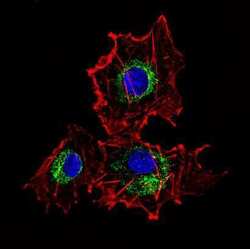
- Experimental details
- Immunofluorescent analysis of Cytokeratin 15 (green) showing staining in the cytoplasm of COS7 cells. Formalin-fixed cells were permeabilized with 0.1% Triton X-100 in TBS for 5-10 minutes and blocked with 3% BSA-PBS for 30 minutes at room temperature. Cells were probed with a Cytokeratin 15 monoclonal antibody (Product # MA5-11344) in 3% BSA-PBS at a dilution of 1:100 and incubated overnight at 4 ºC in a humidified chamber. Cells were washed with PBST and incubated with a DyLight-conjugated secondary antibody in PBS at room temperature in the dark. F-actin (red) was stained with a fluorescent red phalloidin and nuclei (blue) were stained with Hoechst or DAPI. Images were taken at a magnification of 60x.
- Submitted by
- Invitrogen Antibodies (provider)
- Main image
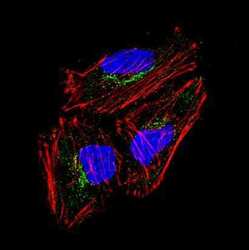
- Experimental details
- Immunofluorescent analysis of Cytokeratin 15 (green) showing staining in the cytoplasm of Hela cells. Formalin-fixed cells were permeabilized with 0.1% Triton X-100 in TBS for 5-10 minutes and blocked with 3% BSA-PBS for 30 minutes at room temperature. Cells were probed with a Cytokeratin 15 monoclonal antibody (Product # MA5-11344) in 3% BSA-PBS at a dilution of 1:100 and incubated overnight at 4 ºC in a humidified chamber. Cells were washed with PBST and incubated with a DyLight-conjugated secondary antibody in PBS at room temperature in the dark. F-actin (red) was stained with a fluorescent red phalloidin and nuclei (blue) were stained with Hoechst or DAPI. Images were taken at a magnification of 60x.
- Submitted by
- Invitrogen Antibodies (provider)
- Main image
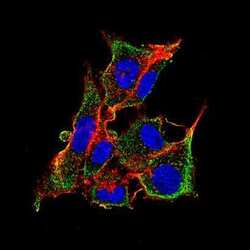
- Experimental details
- Immunofluorescent analysis of Cytokeratin 15 (green) showing staining in the cytoplasm of HepG2 cells. Formalin-fixed cells were permeabilized with 0.1% Triton X-100 in TBS for 5-10 minutes and blocked with 3% BSA-PBS for 30 minutes at room temperature. Cells were probed with a Cytokeratin 15 monoclonal antibody (Product # MA5-11344) in 3% BSA-PBS at a dilution of 1:100 and incubated overnight at 4 ºC in a humidified chamber. Cells were washed with PBST and incubated with a DyLight-conjugated secondary antibody in PBS at room temperature in the dark. F-actin (red) was stained with a fluorescent red phalloidin and nuclei (blue) were stained with Hoechst or DAPI. Images were taken at a magnification of 60x.
- Submitted by
- Invitrogen Antibodies (provider)
- Main image
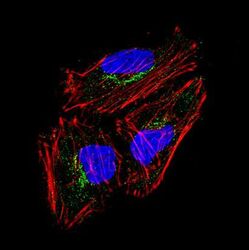
- Experimental details
- Immunofluorescent analysis of Cytokeratin 15 (green) showing staining in the cytoplasm of Hela cells. Formalin-fixed cells were permeabilized with 0.1% Triton X-100 in TBS for 5-10 minutes and blocked with 3% BSA-PBS for 30 minutes at room temperature. Cells were probed with a Cytokeratin 15 monoclonal antibody (Product # MA5-11344) in 3% BSA-PBS at a dilution of 1:100 and incubated overnight at 4 ºC in a humidified chamber. Cells were washed with PBST and incubated with a DyLight-conjugated secondary antibody in PBS at room temperature in the dark. F-actin (red) was stained with a fluorescent red phalloidin and nuclei (blue) were stained with Hoechst or DAPI. Images were taken at a magnification of 60x.
- Submitted by
- Invitrogen Antibodies (provider)
- Main image
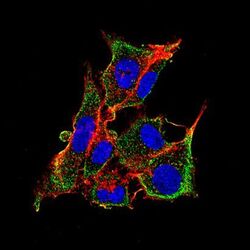
- Experimental details
- Immunofluorescent analysis of Cytokeratin 15 (green) showing staining in the cytoplasm of HepG2 cells. Formalin-fixed cells were permeabilized with 0.1% Triton X-100 in TBS for 5-10 minutes and blocked with 3% BSA-PBS for 30 minutes at room temperature. Cells were probed with a Cytokeratin 15 monoclonal antibody (Product # MA5-11344) in 3% BSA-PBS at a dilution of 1:100 and incubated overnight at 4 ºC in a humidified chamber. Cells were washed with PBST and incubated with a DyLight-conjugated secondary antibody in PBS at room temperature in the dark. F-actin (red) was stained with a fluorescent red phalloidin and nuclei (blue) were stained with Hoechst or DAPI. Images were taken at a magnification of 60x.
- Submitted by
- Invitrogen Antibodies (provider)
- Main image
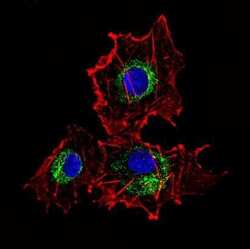
- Experimental details
- Immunofluorescent analysis of Cytokeratin 15 (green) showing staining in the cytoplasm of COS7 cells. Formalin-fixed cells were permeabilized with 0.1% Triton X-100 in TBS for 5-10 minutes and blocked with 3% BSA-PBS for 30 minutes at room temperature. Cells were probed with a Cytokeratin 15 monoclonal antibody (Product # MA5-11344) in 3% BSA-PBS at a dilution of 1:100 and incubated overnight at 4 ºC in a humidified chamber. Cells were washed with PBST and incubated with a DyLight-conjugated secondary antibody in PBS at room temperature in the dark. F-actin (red) was stained with a fluorescent red phalloidin and nuclei (blue) were stained with Hoechst or DAPI. Images were taken at a magnification of 60x.
Supportive validation
- Submitted by
- Invitrogen Antibodies (provider)
- Main image
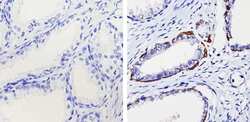
- Experimental details
- Immunohistochemistry analysis of Cytokeratin 15 showing staining in the cytoplasm of paraffin-treated human prostate tissue (right) compared with a negative control in the absence of primary antibody (left). To expose target proteins, antigen retrieval was performed using 10mM sodium citrate (pH 6.0), microwaved for 8-15 min. Following antigen retrieval, tissues were blocked in 3% H2O2-methanol for 15 min at room temperature, washed with ddH2O and PBS, and then probed with a Cytokeratin 15 monoclonal antibody (Product # MA5-11344) diluted by 3% BSA-PBS at a dilution of 1:200 overnight at 4°C in a humidified chamber. Tissues were washed extensively in PBST and detection was performed using an HRP-conjugated secondary antibody followed by colorimetric detection using a DAB kit. Tissues were counterstained with hematoxylin and dehydrated with ethanol and xylene to prep for mounting.
- Submitted by
- Invitrogen Antibodies (provider)
- Main image
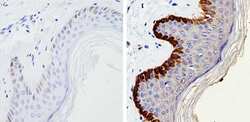
- Experimental details
- Immunohistochemistry analysis of Cytokeratin 15 showing staining in the cytoplasm of paraffin-treated human skin tissue (right) compared with a negative control in the absence of primary antibody (left). To expose target proteins, antigen retrieval was performed using 10mM sodium citrate (pH 6.0), microwaved for 8-15 min. Following antigen retrieval, tissues were blocked in 3% H2O2-methanol for 15 min at room temperature, washed with ddH2O and PBS, and then probed with a Cytokeratin 15 monoclonal antibody (Product # MA5-11344) diluted by 3% BSA-PBS at a dilution of 1:200 overnight at 4°C in a humidified chamber. Tissues were washed extensively in PBST and detection was performed using an HRP-conjugated secondary antibody followed by colorimetric detection using a DAB kit. Tissues were counterstained with hematoxylin and dehydrated with ethanol and xylene to prep for mounting.
- Submitted by
- Invitrogen Antibodies (provider)
- Main image
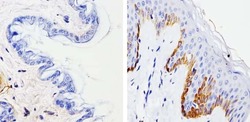
- Experimental details
- Immunohistochemistry analysis of Cytokeratin 15 showing staining in the cytoplasm of paraffin-treated mouse skin tissue (right) compared with a negative control in the absence of primary antibody (left). To expose target proteins, antigen retrieval was performed using 10mM sodium citrate (pH 6.0), microwaved for 8-15 min. Following antigen retrieval, tissues were blocked in 3% H2O2-methanol for 15 min at room temperature, washed with ddH2O and PBS, and then probed with a Cytokeratin 15 monoclonal antibody (Product # MA5-11344) diluted by 3% BSA-PBS at a dilution of 1:200 overnight at 4°C in a humidified chamber. Tissues were washed extensively in PBST and detection was performed using an HRP-conjugated secondary antibody followed by colorimetric detection using a DAB kit. Tissues were counterstained with hematoxylin and dehydrated with ethanol and xylene to prep for mounting.
Supportive validation
- Submitted by
- Invitrogen Antibodies (provider)
- Main image

- Experimental details
- NULL
- Submitted by
- Invitrogen Antibodies (provider)
- Main image
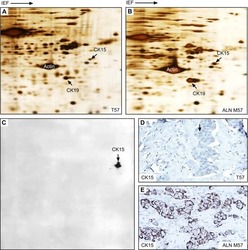
- Experimental details
- NULL
- Submitted by
- Invitrogen Antibodies (provider)
- Main image
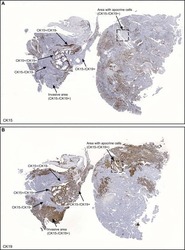
- Experimental details
- NULL
- Submitted by
- Invitrogen Antibodies (provider)
- Main image
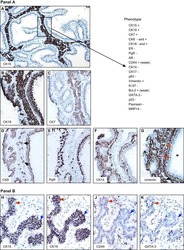
- Experimental details
- NULL
- Submitted by
- Invitrogen Antibodies (provider)
- Main image
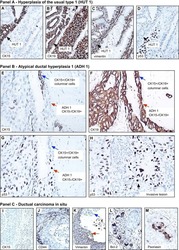
- Experimental details
- NULL
- Submitted by
- Invitrogen Antibodies (provider)
- Main image
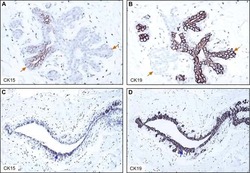
- Experimental details
- NULL
- Submitted by
- Invitrogen Antibodies (provider)
- Main image
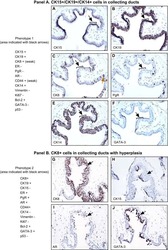
- Experimental details
- NULL
- Submitted by
- Invitrogen Antibodies (provider)
- Main image
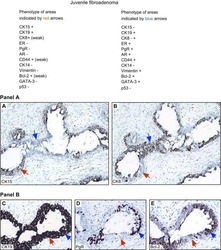
- Experimental details
- NULL
- Submitted by
- Invitrogen Antibodies (provider)
- Main image
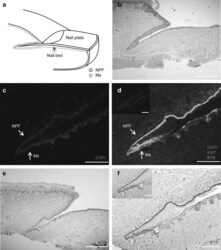
- Experimental details
- Fig. 1 Localisation of stem cells in human nails. Side view, components of the human nail a Red circles are cells in nail proximal folds (NPFs); green circles are cells in the nail matrix (Mx). We found K15 + label-retaining cells in human nails in both the NPF and Mx. The diagrammatic drawing shows the tangent plane of the slice. b H&E staining of human nail side facing showing the nail bed (NB), nail root at the Mx and the NPF junction (scale bar = 1000 mum). c, d Immunofluorescence staining for K15 (green) and Ki67 (red); cell nuclei were stained blue by DAPI, image of separately staining of Ki67 in the upper left corner. The positive expression of K15 extended from the PF to the proximal Mx (scale bar = 200 mum). e Immumohistochemical staining for K15 (brown) (scale bar = 1000 mum). f Magnified photographs of immumohistochemical staining for K15 (brown) (scale bar = 200 mum). (Color figure online)
- Submitted by
- Invitrogen Antibodies (provider)
- Main image
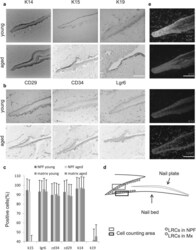
- Experimental details
- Fig. 2 Expression of stem cell markers and the difference between young and aged participants in human nail stem cells. a Immunohistochemical staining for K14, K15, and K19 in human nails. These three markers were all expressed in the NPF and Mx in both groups. Compared to K14 and K15, the expression of K19 was relatively weak, but there was no significant difference between the two groups (scale bar = 400 mum). b Immunohistochemical staining for CD29, CD34, and Lgr6 in human nails. The markers were expressed in the same area (scale bar = 400 mum). c Proportion of positive cells stained for K14, K15, K19, CD29, CD34, and Lgr6 in analysed slices (n = 58, p > 0.05), illustrating no significant difference between the two groups. d Diagrammatic drawing of the nail root. The area in the blue and black box was used to determine the percentage of positive cells. e Co-immunofluorescence staining for K14 and K15 (scale bar = 400 mum). (Color figure online)
- Submitted by
- Invitrogen Antibodies (provider)
- Main image
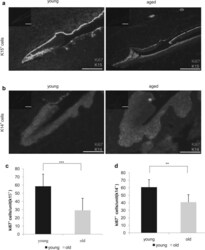
- Experimental details
- Fig. 4 Comparison of cell proliferation between the young and aged groups. a Comparison of Ki67-positive cells with K15 positivity in the two groups (scale bar = 200 mum), image of separately staining of Ki67 in the upper left corner. c Ki67-positive cell count results; the young group was higher than the aged group (n = 58, p = 0.0005). b, d Comparison of Ki67-positive cells with K14 positivity in the two groups and Ki67-positive cell count results (scale bar = 200 mum), image of separately staining of Ki67 in the upper left corner. Similar results were obtained for both K14 and K15 staining (n = 58, p = 0.002). **P < 0.01 ***P < 0.001
- Submitted by
- Invitrogen Antibodies (provider)
- Main image
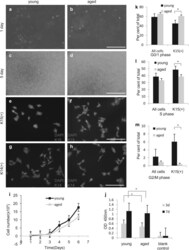
- Experimental details
- Fig. 5 Comparison of nail stem cell proliferation and viability between the young and aged groups. a - h, i Nail stem cell characterisation. When cultured in DKSFM, the cells tended to clump together ( a, b ; scale bar = 1000 mum) and showed high proliferation capacity ( c, d, i ; scale bar = 200 mum). e - h Immunofluorescence staining for K14, K15 (green), and cell nuclei (DAPI/blue) (scale bar = 200 mum). j After seeding, cell viability was evaluated by CCK assays; the cell metabolic activity of the young group was significantly higher than the aged group (p = 0.04). k - m Flow cytometric analysis of total (left side graphs) or K15(+) (right side graphs) cell cycle status in young versus old nail preparations (p < 0.05). *P < 0.05. (Color figure online)
 Explore
Explore Validate
Validate Learn
Learn Western blot
Western blot Immunocytochemistry
Immunocytochemistry